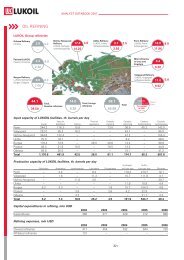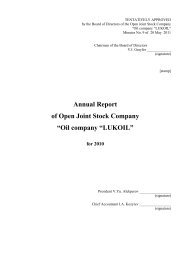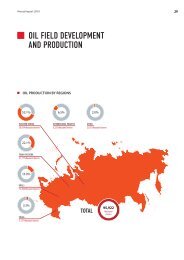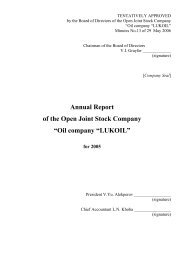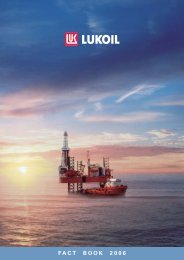ANNUAL REPORT 2005 - Lukoil
ANNUAL REPORT 2005 - Lukoil
ANNUAL REPORT 2005 - Lukoil
You also want an ePaper? Increase the reach of your titles
YUMPU automatically turns print PDFs into web optimized ePapers that Google loves.
MAIN MACROECONOMIC FACTORS AFFECTING OUR RESULTS OF OPERATIONS<br />
Change in the price of crude oil and refined products<br />
The price at which we can sell crude oil and refined products is the primary driver of our revenues. During <strong>2005</strong> crude<br />
oil prices steadily increased due to growth of the world economy, driven mainly by the USA and China, and increased<br />
worldwide crude oil consumption accompanied by refining and distribution bottlenecks in some major consuming regions.<br />
In the August <strong>2005</strong> crude oil prices reached their historical records in absolute terms as a result of a crude oil supply<br />
interruption in the USA caused by hurricanes Rita and Katrina. According to International Energy Agency (IEA) in <strong>2005</strong> the<br />
world demand for crude oil and, subsequently, refined products reached the level of 83.3 million barrels per day, which<br />
is 1.3% more than in 2004 and 5.2% more than in 2003. Based on OPEC's data, its actual daily production in <strong>2005</strong><br />
reached 30.0 million barrels a day, or 2.6% more than in 2004, which is near OPEC's full capacity. The current market<br />
situation is also influenced by high political and natural risks, which could cause crude oil production to decrease. This<br />
situation can be viewed as an indicator that crude oil prices will remain steadily high in a medium-term perspective.<br />
Substantially all of the crude oil that we sell for export is the Urals blend. The following table shows the average crude<br />
oil export prices for <strong>2005</strong>, 2004 and 2003 and refined product prices based on Northern Europe averages.<br />
ANALYSIS OF FINANCIAL CONDITION<br />
AND RESULTS OF OPERATIONS<br />
<strong>2005</strong><br />
Change<br />
from 2004<br />
2004<br />
Change<br />
from 2003<br />
2003<br />
(in US dollars per bbl, except for figures in percent)<br />
Brent crude 54.31 41.9% 38.27 33.3% 28.71<br />
Urals crude (CIF Mediterranean)* 50.67 46.9% 34.50 27.6% 27.03<br />
Urals crude (CIF Rotterdam)* 50.12 46.9% 34.13 26.6% 26.96<br />
(in US dollars per metric tonne, except for figures in percent)<br />
Fuel oil 3.5% (FOB Rotterdam) 229.92 51.4% 151.81 2.3% 148.37<br />
Diesel fuel (FOB Rotterdam) 505.01 44.5% 349.37 37.8% 253.53<br />
High-octane gasoline (FOB Rotterdam) 534.11 33.4% 400.33 35.2% 296.13<br />
* The Company sells crude oil on foreign markets on various delivery terms. Thus, the average realized sale price of oil on<br />
international markets differs from the average prices of Urals crude on Mediterranean and Northern Europe markets.<br />
Domestic crude oil prices<br />
Substantially all crude oil produced in Russia is produced by vertically integrated oil companies such as ours, as a result<br />
most transactions are between affiliated entities within vertically integrated groups. Thus, there is no concept of a benchmark<br />
domestic market price for crude oil. Essentially, crude oil prices on traditional international markets will be higher<br />
than those in Russia due to incremental transportation cost incurred to deliver the crude oil from the Russian border to<br />
the markets, and export tariffs. However, the price of crude oil that is produced but not refined or exported by one of the<br />
vertically integrated oil companies is generally determined on a transaction-by-transaction basis against a background of<br />
world market prices, but with no direct reference or correlation. At any time there may exist significant price differences<br />
between regions for similar quality crude oil as a result of the competition and economic conditions in those regions.<br />
Domestic refined product prices<br />
Domestic prices for refined products are determined to some extent by world market prices, but they are also directly<br />
affected by local demand and competition. In general, retail prices on refined products in Russia are comparable to those<br />
in the USA. For example, during <strong>2005</strong> the average retail price on regular gasoline in the USA was about 60 cents per litre,<br />
an increase of 22.0% compared to 2004. In central regions of European Russia the average retail price on gasoline of the<br />
same quality (95 octane) during <strong>2005</strong> was about 57 cents per litre, an increase of 22.0% compared to 2004.<br />
103







